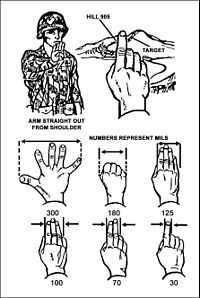Physics and Astronomy Labs/Angular size
< Physics and Astronomy Labs

This lab focuses on estimates and simple measurements of angular size. Angular size, or angular diameter is described in Wikipedia:Angular diameter.
Most labs consist of comparing two different measurements of a given angular size:
- Some sort of protractor is used to measure the angle directly. One such protractor consists of the outstretched hand.
- A ruler is used to measure two lengths, and the angular size is measured by calculation.
The analysis consists of comparing these two measurements of the angle.
Preliminary Investigation
A Preliminary Investigation established that the outstretched hand method is approximately correct. There is evidence that the use of the little finger to measure 1° overestimates the actual angle by about 1/3 of a degree. It was also noted that the hand position used to measure 20° was uncomfortable and might perhaps be replaced by a measurement with the three fingers "up", as shown in figure to the right (except with the thumb and little finger held as far apart as is comfortably possible)
A benefit of this investigation was that the student sketch, File:Estimating angular size with hand.gif was posted on commons and used to improve the Wikipedia article Angular diameter.
Is the 5 degree value too large?
The picture in the upper right is incorrect. It said that we could measure 5 degrees using out pointer, middle and ring fingers together. We demonstrated that this was not correct using measurements on several students. According to the image, the ratio[1] should be 5:1. We found the standard deviation using the digital caliper Instead of 5 we obtained 3.67 ±.21.
| 3 fingers (mm) | pinkey (mm) | ratio | |
| 45.18 | 13.06 | 3.46 | |
| 44.48 | 12.5 | 3.56 | |
| 48.22 | 13.3 | 3.63 | |
| 54.94 | 15.14 | 3.63 | |
| 55.1 | 13.55 | 4.07 | |
| ave | 49.58 | 13.51 | 3.67 |
| stdev | 5.16 | 0.99 | 0.23 |
| stdev/mean | 10% | 7% | 6% |
What To Do In This Lab
- In this lab you are standing in the back of the room and are holding your pinky up until the two dots on the board are exactly on each side of the pinky.
- After that you measure how far apart the two dots are on the board.
- Then you have to figure out the distance from wall to wall and this classroom’s distance was 328 inches.
Comparison of two hand positions for 20 degrees
This Comparison of two hand positions for 20 degrees needs to be briefly described here.
Links and image gallery
Wikipedia: Angular_diameter Angular_mil Arcs of circles
Wikiversity: Trigonometry/Angles Physics_equations/Equations#00-Mathematics_for_this_course
- ↑ pinky to three fingers

